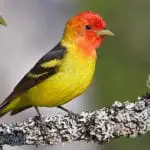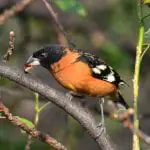Scientific Facts
| Common Name | Blue Grosbeak |
| Scientific Name | Passerina caerulea |
| Lifespan | More than 7 Years |
| Size | 5.9 – 6.3 inches |
| Mass | 0.92 – 1.11oz. |
| Habitat | Partly open woodland |
| Range | North and Central America |
Information & Physical Appearance
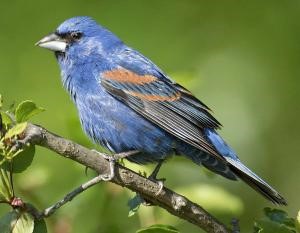
The Blue Grosbeak, with the binomial name Passerina caerulea, belongs to the order Passeriformes, the family Cardinalidae.
This is a medium-sized bird species. It is characterized by a triangularly-shaped bill, which appears as if covering the entire front zone of the bird’s face, starting from the throat and reaching up to the forehead.
This stocky songbird is slightly smaller than a brown-headed cowbird and larger in size as compared with an indigo bunting. The wingspan is 11 inches.
Breeding adult male blue grosbeaks display a deep, vivid, rich blue coloration overall. They have a tiny-sized black mask. The large beak is black-and-silver in color, and the wing bars exhibit a warm chestnut tone.
Nonbreeding adult males are patchy blue.
Blue grosbeaks are sexually dimorphic; hence, the physical appearance of females greatly differs from males’.
The finch-like adult female blue grosbeaks are mostly ample cinnamon-brown, with the color being visibly richer on the head, while paler on the underparts. Also, the underparts are unstreaked.
Females’ tails are bluish.

Female blue grosbeak – Image Source
A common trait in both sexes is that the lower wing bars display grayish to buffy coloration, while the upper is chestnut.
Immature Blue Grosbeaks resemble the appearance of adult females. They tend to be rich, dark chestnut brown in color and are further characterized by chestnut wingbars.
Below are several key points to help one tell blue grosbeaks apart from other similar bird species.
- Adult males are deep blue, with 2 rusty, broad wing bars
- Adult females are tan with solid, unstreaked underparts, two rusty wing bars, and a rump colored in light blue
- The song is a melodious, burry warble
- These birds will habitually spread and twitch their tails sideways
- These birds prefer thicket, shrubby areas located close to fairly open pieces of land
- Finch-like birds with triangular, heavy, large, silvery-colored bills
The bird species that are most similar to the blue grosbeak include the indigo bunting, the brown-headed cowbird, the eastern bluebird, and the lazuli bunting.
1. Apart from being closely related with the indigo bunting, blue grosbeaks also look quite similar to this bird species. Both species can appear equally blackish in particular lighting. However, the indigo bunting is more sparrow-like, rather than finch-like.
Also, the indigo bunting is significantly smaller in size and possesses a smaller bill. Adult male indigo buntings lack the rusty wing bars typical for blue grosbeaks.
While indigo buntings are fairly common statewide, this is not the case with blue grosbeaks, as they tend to be rare to uncommon, as well as hard to see, in many parts of Missouri.
2. When compared with Missouri’s state bird (the eastern bluebird), blue grosbeaks have much heftier bills, while the eastern bluebird’s bill is much thinner.
Additionally, in both sexes of the eastern bluebird, the belly zone is white in color, and the breast displays orangish tones.
3. It is easy to confuse blue grosbeaks with brown-headed cowbirds, especially as blue grosbeaks can appear quite blacking in poor light. Both of these bird species are about the same size. Plus, they share similar habitats.
However, the bill of the brown-headed cowbird is visibly narrow and is blackbird-type. Cowbirds do lack wing bars.
Not the least, cowbirds do not share the blue grosbeak’s curious tail-twitching habit.
4. The lazuli bunting is the blue grosbeak’s closest relative. As compared with male blue grosbeaks, male lazuli buntings are smaller in size. Also, they are distinguishable from the blue grosbeak by a white belly and an orangish breast.
Lifespan
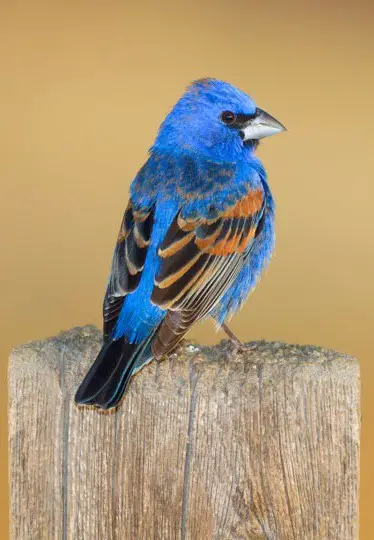
Based on the available study, blue grosbeaks can live to at least 7 years of age.
The oldest recorded blue grosbeaks was a male. The individual was recaptured and then re-released into the wild during banding operation that took place in Virginia. The oldest specimen was estimated to be at least 7 years and 2 months of age.
The generation length is estimated at 4.2 years.
Ecosystem & Habitat
The blue grosbeak is a migratory bird known to nest across most of the southern half of the United States. Also, this bird species’ nesting grounds extend across much of northern Mexico.
Blue grosbeaks migrate south to Central America. Although small in numbers, some migrate to the northern parts of South America.
The southernmost migration record for this bird species is eastern Ecuador.
Blue grosbeaks are found in partially open habitats, including cultivated lands, thickets, hedgerows, overgrown fields, or woodland edge. They share an affinity for habitats characterized by scattered trees, scrub, as well as for riparian woodland.
When it comes to nesting, this bird species choose to build a nest in a low bush or in a low tree. It is often the case that these birds nest in a tangle of vegetation.
Ultimately, the nest is constructed at about 3.3 and up to 9.8 feet above the ground. Usually, it is positioned at the very edge of an open area.
Breeding takes place in shrub habitats and in tangled vine across the southern portions of North America, expanding as far as central California in the west, New Jersey in the East, and to North Dakota in the inner parts of the US.
Breeding habitats may be forest edges, stream edges, old fields, mesquite savannas, transmission-line corridors, deserts, southern pine forests, hedgerows, or salt cedar forests.
The blue grosbeaks’ habitat preferences seem to include only little canopy coverage, a small number of trees, as well as low shrub density.
During the wintertime, these birds will migrate in order to spend the cold season in the south, in the shrubby habitats of Central America and Mexico, sometimes possibly reaching as far south as the central parts of Panama.
Blue grosbeaks play a valuable role in their ecosystem. Also, they are considered a species of positive impact on humans. It was in the early 20th century when ornithologists carefully studied the diet of these birds with a mind to evaluating their impact on the economy.
During the breeding season, blue grosbeaks were found to consume significantly big amounts of insects that cause damage to the crops, like weevils, cutworms, and grasshoppers.
Even though they were also found to eat a good amount of grain crops shortly after the breeding season, “economic ornithologists” estimated that the blue grosbeaks’ help when it comes to dispatching insect pests did outweigh the cost of seeds consumed while the birds were preparing to migrate south.
Food & Diet
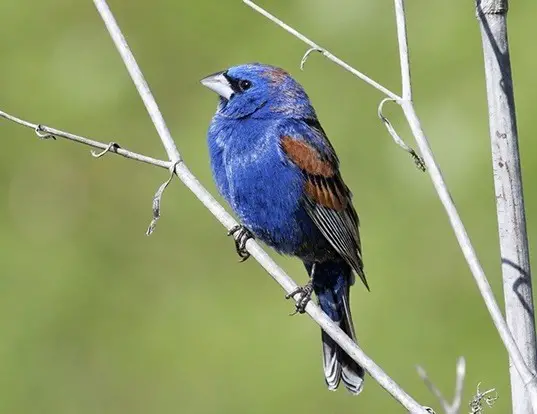
Blue grosbeaks are foragers. These beautiful feathery creatures will either forage directly on the ground, or they will forage in shrubby tangles, searching for seeds, fruits, and insects.
Insects make a big percentage of the blue grosbeaks’ diet during the breeding season, similarly with many other bird species. That’s because insects are rich in protein, which is crucial for the growing young.
The primary sources of protein include crickets and grasshoppers. However, blue grosbeaks will also eat other invertebrates, e.g., snails, beetles, cicadas, caterpillars, and treehoppers.
When the young grosbeaks are to grow up, their diet will include more fruits and seeds, rather than insects.
The grain portion of the blue grosbeaks’ diet consists of various wild and cultivated grains and seeds, like bristlegrass, wheat, panicgrass, rice, alfalfa, corn, and oats.
Hovering and gleaning food from foliage, blue grosbeaks may even hunt for insects on the surface of the ground, although for most of their time, they will sally out from a perch for flying insects.
Behavior
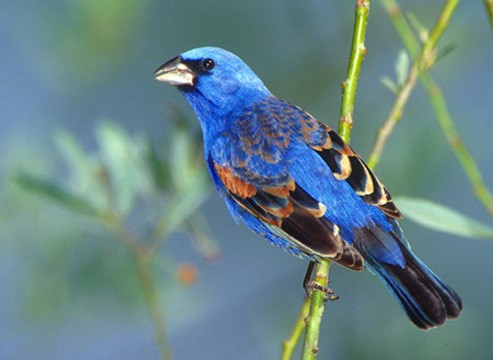
Breeding males are believed to arrive on the breeding grounds earlier than females. Once they arrive early in the breeding season, they are to form feeding flocks.
Both males and females in the breeding pair are in charge of defending their breeding territory. Typically, the breeding territory encompasses between 2 and up to 20 acres of land occupied by the mating pair during the building of the nest and the incubation of the eggs.
Once the nestlings hatch, the defended breeding territory is to shrink in size.
Blue grosbeaks are thought to be monogamous. In a single breeding season, blue grosbeaks may raise up to 2 broods.
Brown-headed cowbirds (Molothrus ater) are known to heavily parasitize Blue Grosbeaks’ nests. Cowbirds are to lay their own eggs in the blue grosbeaks’ nests.
Young blue grosbeaks and adults alike are known to gather together in large flocks in order to feed in rice fields, grasslands, and grain fields, shortly before they are to migrate south to their wintering quarters.
While waiting for the females to arrive in the spring, males are to flock and feed together.
One of the factors, when a female is to select a breeding partner, is believed to be the inspection of the quality of the male, which is estimated based on the ultraviolet structural ornamentation in the males’ feathers.
It is during the summer months when mixed flocks of males and females will feed together.
Most commonly, these birds are seen flying low over the surface of the ground while foraging. However, they may sometimes hop awkwardly, too.
Breeding males are known to follow their breeding female partner very closely, and so the pairs are frequently seen together.
The blue grosbeak is known to be rather shy around humans. This makes observation quite challenging.
In both sexes, tail flicking is a commonly observed behavior, yet the very purpose of this behavior remains unknown.
Interestingly, as seen in parrots, blue grosbeaks may sidle along branches.
It is exclusively the male blue grosbeak to sing. The song is described as a rich, long warble, lasting for about 2.5 seconds.
Contrary to the song of related bird species, such as the indigo buntings and the house finches, the blue grosbeaks’ song lacks the common burry qualities.
At the very beginning, the blue grosbeak’s song does not vary significantly from one male to another. However, song endings can vary from individual to individual, potentially consisting of about 11 and up to 19 unique song elements.
The older the male blue grosbeak, the longer the son.
Additionally, there is a strong correlation between female fertility periods and the complexity of males’ songs.
In times of female fertility, males will often use more song variants, consisting of a wider variety of elements and arrangements.
Reproduction & Development
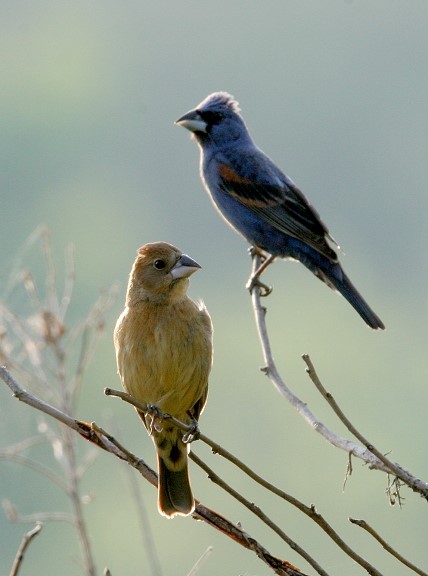
Breeding pair – Image Source
Even though males are to arrive first in the breeding grounds in early spring, females are the ones to do most of the construction of the nest.
With blue grosbeaks, the breeding season extends from the beginning of April to late August.
It is based on sightings of the same paired blue grosbeak individuals multiple times per one single mating season how ornithologists have reached the assumption that this bird species are monogamous.
Up-to-date, the data regarding the courtship behavior of this bird species is rather scarce. However, males are known to guard their mating partner by following the female closely during the course of feeding.
The female blue grosbeak is to build a neat, compact, cup-shaped nest. The nest is made out of a variety of materials woven together, such as rootlets, cotton, dead leaves, twigs, string cellophane, paper, pieces of fabric, and even shredded snakeskins, among others.
Measuring about 2 inches in depth and 2-3 inches across, the inner cup is often lined with fine grasses, hairs, and rootles.
While it is normally the case that females will do most of the nest’s construction, males will sometimes build nests, too.
The nest is typically positioned in dense vegetation, e.g., in low shrubs. When it comes to the nesting location, open areas, like old fields and roadsides, are highly preferable.
The clutch compromises of 3 and up to 5 eggs. The incubation of the eggs takes 12-13 days. The eggs measure 0.8 – 0.9 inches in length and 0.6 – 0.7 inches in width.
The eggs are pale blue to white in color. Occasionally, they may be spotted with brown.
At hatching, the young are characterized by brownish-gray down. They are helpless, and their eyes are closed.
After hatching, the young chicks will remain in the nest for between 9 – 10 days.
Considering their monogamous breeding system, both the parents are known to invest in taking care of their young. Both the male and the female are to feed their chicks after hatching.
In the case of raising two broods per year, the male is to become the primary caretaker for the chicks while the female is to begin building the second nest.
Before an insect is fed to the nestlings, the parents are to remove most of the insects’ legs, as well as the head and the wings.
Health Risks, Survival Threats & Conservation

Possible Health Issues
Based on available research, about 20% of selectively studied blue grosbeaks were found to be infested with feather mites from genus Proctophyllodes.
Blue grosbeaks may also assist in the spreading of various diseases, more specifically, in the spreading of arboviral diseases between mosquitoes and birds. The spread of arboviral diseases is progressively relevant as the blue grosbeaks’ range is expanding northward, where a growing number of new, as well as reemerging diseases, is known to widely occur.
One of the common diseases spread by blue grosbeaks includes Eastern equine encephalitis. In this disease, the vertebrate hosts are usually passerine birds, e.g., the red-eyed vireo.
Currently, the blue grosbeaks’ roles as vectors for Eastern equine encephalitis, among other arboviral diseases, has not been well-studied. However, this particular topic is suggested to need immediate attention.
Conservation
Even though blue grosbeaks are uncommon across the southern United States, they are also widespread.
Overall, their population is stable. In fact, according to data shared by the North American Breeding Bird Survey, it has slightly increased between 1966 and 2014.
Also, based on the information provided by the UICN Red List of Threatened Species, the current population trend is increasing. Conservation sites are identified over the entire range, and while there isn’t an active recovery plan, there is a systematic monitoring scheme.
Meanwhile, Partners in Flight estimate the global breeding population of blue grosbeaks at 24 million.
57% are known to spend some part of the year in Mexico, and 74% are known to spend some part of the year in the United States.
On the Continental Concern Score, blue grosbeaks rate an 8 out of 20. These birds are not on the 2014 State of the Birds Watch List.
It was all the way back in the 19th century when naturalists reported only low densities of blue grosbeaks. In the late 19th century, as well as in the early 20th century, their breeding range has expanded. The possible reason for this expansion is believed to be forest cutting.
Nowadays, blue grosbeaks live at the highest densities, with about 80 breeding males sharing 1 square mile of land in the mixed loblolly-shortleaf pine forests of eastern Texas, and in the old-growth longleaf pine forests of Florida.
Up-to-date, the effects of deforestation and agriculture on blue grosbeaks’ wintering grounds remain unknown.
When it comes to their breeding grounds, blue grosbeaks are believed to possibly benefit from some of the modern-day land-use trends, yet they may be adversely affected by others. For instance, these birds are known to thrive in abandoned agricultural land; however, they are also known to avoid suburban habitats.
Availability – Where to Get a Blue Grosbeak

It tends to be quite a challenging task to get a closer glimpse of the blue grosbeak. These birds are known to avoid interaction with humans in general.
It is often the case that most birders will get to hear a blue grosbeak calling or singing first. Also, it is fairly common for bird watch enthusiasts to only get a quick glimpse of this fairly large bluebird while it is flying between small trees and bushes.
It is possible to attract blue grosbeaks at feeders filled with their favorite seeds or grains. Also, these birds are particularly attracted to shrubby backyards.
Despite the fact that the blue grosbeak is never common during the summer season, and regardless of its retiring habits in general, the males’ natural tendency for singing from the exposed, high perches, as well as these birds’ preference for open habitats, make up for enabling enthusiasts to succeed in locating these amazing feathery fellows throughout most of their range.
For those who want to enjoy the beauty of the blue grosbeak by getting a closer look, it is best to prepare in advance. Learn how to distinguish the sound of their warbling, blurry songs.
Once enthusiasts are to head out hiking and looking for blue grosbeaks, they want to listen for these birds’ songs as the best indicator of their presence nearby.
Additionally, birders want to make sure to continuously check old-field habitat, as well as shrubby habitat, where it is most likely to come across Passerina caerulea.
Note that even when blue grosbeaks seem to be absent early in the summer season, many individuals actually arrive quite later on, e.g., in late July, when the blue grosbeak happens to be one of the few songbirds within such habitats, and hence, it may be spotted easier.
Interesting Facts
- Blue grosbeaks happen to live in many of the same types of habitats as brown-headed cowbirds. Unfortunately, cowbirds are nest parasites. Cowbirds will deposit their eggs in the nests of other birds, such as the blue grosbeak, instead of building their own nests. Thus, the parasitized birds will unwittingly rear the cowbirds’ young. Usually, this occurs at the expense of being able to rear their own young. Cowbirds are known as heavy nest parasites of blue grosbeaks.
- According to existing reports, it is the blue grosbeaks that inhabit the southern part of the breeding range to most frequently raise two broods of nestlings instead of a single brood per year.
- As blue grosbeaks breed along with open areas and roads, constructing their nests in low shrubs, briars, small trees, or tangles of the vine, a minimum of one pair of breeding grosbeaks is known to have nested in a bluebird nest box.
- Based on genetic evidence, the closest relative of the Blue Grosbeak is none other but the Lazuli Bunting.
- It is often the norm for many Blue Grosbeaks to migrate directly southward when moving to their wintering grounds from their breeding areas. Eastern birds are known to cross the Gulf of Mexico, while western birds are known to head overland. While migrating, grosbeaks will pass through the Islands of the Caribbean, including the Cayman Islands, the Bahamas, the Turks, the Swan Islands, the Caicos Islands, the Antilles, the Virgin Islands, and Puerto Rico.
- Possibly because of taking advantage of forest clearing, the blue grosbeaks’ range has expanded farther into the northern parts throughout the US within the past century or two.
- The Spanish word for Blue grosbeak is Azulillo Grande. This bird species is called Guiraca bleu in French.
- The blue color is the rarest color in nature.
Blue is fairly uncommon, as it does not occur like other pigments. Specifically, most of the pigments exhibited on the fur, feathers, and/or skin of various species of animals are related to the food the species choose to consume.
For instance, goldfinches get their yellow coloration from the yellow flowers they eat, while salmon gets its pink coloration because of eating pink shellfish. Unlike color pigments, such as brown, orange, red, and yellow, which are derived from the specific food animals consume, this is not the case with blue.
In reality, the blue color we see on different animals, including but not limited to the blue grosbeak, is not really a pigment at all.
Instead, whenever the color blue is to appear in nature, it is associated with other reasons rather than pigment.
The blue color is often due to the very structure of the molecules, and more precisely, to the way these molecules reflect light.
In the case with bluebirds, like the blue grosbeak or the blue jay, among others, the blue color we see is a result of the structure of each feather. Each feather consists of microscopic, tiny-sized, light-scattering beads. These beads are spaced in such a manner as to cancel out everything except for blue light.
Ultimately, the blue coloration on just about any animal, including blue eyes in humans, is a result of some form of light reflection.
The only animal in the world that is actually known to produce its very own blue pigment is the obrina olivewing butterfly.
Up-to-date, scientists still cannot tell for sure why the color blue is only found in specific blue structures, rather than being related to pigments.
However, according to a popular theory, the development of blue color may have become beneficial to some species because of communication and survival. From an evolutionary perspective, it is generally much easier for blue colored animals to change the shapes of their bodies in super microscopic ways, rather than having to rewrite the very laws of chemistry.
How to Care for the Blue Grosbeak
For bird care enthusiasts who happen to have plenty of bushy cover in their backyard or garden, blue grosbeaks may gladly visit backyard bird feeders, as long as these are filled with fresh seeds and grains, such as oats, wheat, rice, and corn, among others.
Do not forget that in order to take the best care for the blue grosbeak, it is imperative to carefully clean the entire bird feeder, as well as the area around the bird feeder, on a regular basis. Otherwise, you risk exposing blue grosbeaks to nasty diseases that may be easily spread among birds sharing feeders.
In addition to that, one of the most reliable ways to take care of the blue grosbeak is to keep sharing the story of this amazing bird species, along with curious facts, with friends and family. By nurturing a deep love and respect for all the living beings created by Mother Nature, we can all contribute to making this world a better place, and ultimately preserve the wildlife biodiversity of the planet.
FAQs
Is There a Blue Grosbeak?
Yes, there is a blue grosbeak, and its scientific name Passerina caerulea. This is a medium-sized songbird that belongs to the same family as northern cardinals, with blue grosbeak breeding males being almost entirely rich blue in color, while the females are primarily brownish.
Where Do Blue Grosbeaks Live?
During their nonbreeding season, blue grosbeaks usually live in open weedy fields characterized by shrubs, with their warbling song being a fairly common sound during the summer if one is to walk nearby hedgerows and thickets in the southern US states.
What Does a Blue Grosbeak Eat?
The blue grosbeak eats a large quantity of live food rich in protein, such as snails, spiders, grasshoppers, cicadas, and beetles, and it is in the breeding season when insects are most heavily consumed. Blue grosbeaks also eat a proper amount of seeds, wild fruits, and grains by spending their days foraging in trees and shrubs, as well as on the ground.
Where Do Blue Grosbeaks Nest?
It is in small shrubs, trees, briars, and tangles of vines, among other vegetation, where blue grosbeaks choose to build a nest. It is most commonly the case that blue grosbeaks choose to nest near roads or other open areas.
How Big is a Blue Grosbeak?
The blue grosbeak is a bird species of medium size. It is larger than an indigo bunting, but a bit smaller than a brown-headed cowbird, reaching between 5.9 – 6.3 inches in length and attaining a body mass of up to 1.11oz.
How to Attract Blue Grosbeaks?
Blue grosbeaks tend to be harder to attract to one’s backyard, as compared with other grosbeaks. The best way to attract blue grosbeaks is to have plenty of shrub cover in your garden/yard and to use a hopper style seed feeder filled with corn, rice, wheat, or black oil sunflower seeds, while also making sure to provide proper perching space.
Are Blue Grosbeaks Rare?
Although widespread, blue grosbeaks are not common, and it is true to state that these are rare birds to come across, especially since they tend to shy off from interacting with humans.
Are Blue Grosbeaks Endangered?
Blue grosbeaks are listed as Least Concern on the IUCN Red List of Threatened Species and are not considered severely endangered with extinction. Currently, their population trend is increasing, yet it remains unknown how the ongoing changes in climate will affect this bird species in the foreseeable future.


